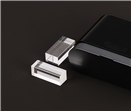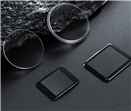Inventory: In 2018, domestic technology continuously breaks through 22 nanometer lithography machine, 450 kilograms of artificial sapphire, 0.12 mm glass...
Time:2019-07-30
In 2018, high-tech achievements blossomed in all walks of life, and while improving industrial efficiency, it also created more convenience for people's lives. The main body of scientific and technological innovation is in line with the goal of “mastering the core technology independently and breaking the monopoly of foreign countries”.
Smart water knife
In the 4th exhibition of high-tech equipment for the integration of military and civilian development in October, a magical water knife attracted the audience to stop. It uses water as a blade to cut a variety of materials, separating sponges, cutting through rocks, cutting steel, and winning laser cutting. Its full name five-axis five-link intelligent waterjet, developed and produced by Shanghai Lionmai Technology Co., Ltd. (hereinafter referred to as Lion Mai Technology), fully possesses independent intellectual property rights.
The water knife principle is very similar to the water guns that children play. Pressurize ordinary tap water to above 4000 atmospheres, forcing the pressurized water to be ejected from a small nozzle to form a high-speed jet. In this high-speed jet, sharply broken small particles are added to form a high-speed abrasive jet.
The water knife has a huge energy, and the high-pressure water high-speed jet strikes the cutting object at a speed of 3 times to achieve cutting. Compared to the “predecessor” laser cutting, the waterjet cutting process is a high-speed grinding and rapid cooling process, no thermal damage and thermal deformation, no smoke and dust, and green. Simply put, the laser can not be cut, the water knife can cut. Both Boeing and Airbus use a large number of intelligent waterjets for machining.
Waterjet, laser and plasma cutting are difficult to achieve precision cutting. After three years, lion technology has developed a unique high quality control system. Through the use of mathematical models to accurately predict the error of each point on the popular walking path, the precise control of the speed, acceleration, yaw angle of the cutting head and the characteristic parameters of the jet can be achieved, and the cutting efficiency can be maximized. A high-precision target that automatically eliminates errors.
Iris recognition 1.2 meters away two seconds to get
Iris recognition is the most reliable biometric technology other than DNA, the only, anti-counterfeiting. At first, iris recognition was to attach the eye to the device like a telescope, and then expanded to the device to identify it within half a meter. In November, Hongxing Technology officially put into operation the "driver biometric identification integrated machine", expanding the iris recognition distance to 1.2 meters, and you can take a glance at it without any cooperation.
Everyone's iris is unique. Under infrared light conditions, it can display rich texture characteristics and stabilize more than 200 feature points. After brushing the eye, the instrument extracts the feature code with high discriminating power and compares it with the database. This process is called iris recognition. The advantages of iris recognition are mainly reflected in the accurate search of people in a huge database. Accurately find a person in the surveillance video, the 10,000 population base uses face recognition, 100,000 people use fingerprint recognition, and 1 million people should use iris recognition.
The iris is only about 1 square centimeter, the face is 300 square centimeters, and the recognition difficulty is 300 times different. A little further away, it is difficult to collect a clear iris texture; and the shaking and blinking of the person itself will cause a series of problems such as motion blur and eyelid occlusion.
Hongxing Technology uses more than 10 million pixels of image sensor to ensure sufficient iris resolution; carefully calculate the angle and intensity of the near-infrared light source, illuminate the iris texture without harming the human eye; move the intelligent algorithm to imaging In the device, imaging and calculation work together; fast image quality judgment algorithm, discard low-quality images, focus on identifying high-quality iris images; optimization algorithm, processing hundreds of tens of millions of pixels of iris images in one second. Finally, iris recognition was performed for 2 seconds within 1.2 meters.
Submarine shield machine
The shield machine that hits the undersea tunnel can only be digged and cannot be retreated. Equipment worth tens of millions of yuan is often "going back." On August 20th, in the submarine tunnel of Xiamen Metro Line 3, the last cutterhead was removed, and the shield machine on the seabed was successfully regressed for the first time in the world.
The shield machine is a hole-punching expert. Its head is a disc full of "teeth", which rotates continuously, removes dirt and stones, and has a motor and mud in a long cylinder weighing more than 100 meters and weighing about 800 tons. Circulating pipes. The new space behind it is tiled with curved cement segments, and the tunnel is formed. However, the shield construction method makes the hole diameter behind the body smaller, so the shield machine can not retreat, and is usually permanently sealed in the dead end next to the tunnel.
However, the Xiamen Metro Line 3 submarine tunnel construction side of the China Railway Iron and Steel Bureau Urban Rail Company came up with a way to remove the shield machine. They asked the experts to study the tilting method of adjusting the cutting angle without rotating the cutter head, and overcome the problem of the cutter disc removal.
The sea tunnel is 40 ° C high temperature, and the disassemble is cut by flame, which is quite dangerous. To this end, the dismantling machine "three shifts", a high-power electric fan ventilation is added every 100 meters in the tunnel. The detailed disclosure before the dismantling, the preparation of the fire facilities before the hot work, and the real-time detection of the gas in the hole in the hot fire. And custom-made heavy-duty trucks solve the problem of transporting 65 tons of parts at a time.
In the end, the dismantling period was less than one month, and more than 14,000 parts of the shield machine were safely removed and shipped back to the warehouse. The shell of the shield machine is left in the tunnel to make the inner wall. This has created another project in China.
Artificial sapphire 450 kg record
At the beginning of 2018, 450 kg of artificial sapphire was born in China. Take the world's highest weight, the largest single artificial sapphire crystal "laurel". The world record of 350 kg in Russia will be increased by 100 kg in 2017.
Artificial sapphire is an important raw material in high-tech production. Small to smart phone camera, touch screen, LED lights, large to the country, high-intensity laser, astronomical observing system optical components, the application is increasingly widespread.
Since the new century, China's sapphire production equipment and production processes still rely heavily on imports. In particular, China's production capacity and product size can not meet the comprehensive needs of national defense technology and national heavy equipment.
This artificial sapphire is based on the world's mainstream production technology. The principle is that the alumina raw material is heated to the melting point to form a melt, and then the seed crystal rod contacts the surface of the molten soup, and the single crystal of the same crystal structure is grown on the solid-liquid interface between the seed crystal rod and the molten soup. The seed crystal is pulled up at a very slow rate and finally solidified into a single single crystal wafer.
This process is long and has extremely demanding requirements for furnace temperature control and production system coordination. The production of 450 kg class products, and the production of 200 kg class, 350 kg class products, the technical requirements are not at one level, there is a qualitative difference. Zhang Jun, general manager of the company, said: "Our core technology is self-developed automated production equipment, thermal production design theory and micro-process applications, from raw material selection, processing, production, all made in China."
The thinnest glass is only 0.12 mm thick
After 0.15 mm, Chinese technicians pursued the ultimate, pulling out 0.12 mm of ultra-thin electronic touch glass, and creating the world record for the industry's thinnest glass production by float technology. In May, Suizhong Building Materials Information Display Materials Co., Ltd. released a new batch of ultra-thin glass.
The thickness of ultra-thin glass is between 0.1 and 1.1 mm, which can be used as the basic material for mobile phones, computers and TV displays. The thinner the glass, the better the light transmission and flexibility, and the easier it is to break. However, the newly developed 0.12 mm ultra-thin glass is bent into a ring shape and will not break.
For every 0.1 mm drop in glass thickness, the added difficulty of production is beyond imagination. From 0.3 mm in 2013 to 0.12 mm as thin as paper, the company solved the four problems of glass thinning, micro-defects, design and manufacture of three thermal equipments and glass formulation, and developed cold-cutting of glass. A series of technical means such as transportation, on-line detection of defects.
From 0.15 mm to 0.12 mm, it is almost indistinguishable from the naked eye by 0.03 mm, and the team has been working for 2 years. After melting more than 1,000 technical bottlenecks in the melting process, molding process, cutting process, inspection packaging and equipment technology, the world's thinnest 0.12 mm float glass was finally born. A few years ago, the glass and equipment of hundreds of display panel production lines in China were completely dependent on imports. Now the domestic ultra-thin glass technology is internationally leading and highly competitive. The price of the display has dropped, and the electronic products are relatively more affordable. At present, the company has begun to develop 0.1 mm ultra-thin glass.
Spacecraft recycling weight pushed to more than 7 tons
Rocket recycling and reuse is an important label for Musk SpaceX. In fact, China has also recovered the 3.5-ton Shenzhou spacecraft manned cabin. In November, 508 of the Aerospace Five Institutes verified the key technologies to push the recovery weight of China's spacecraft to more than 7 tons. This is inseparable from the successful development of a large group umbrella system and a large load landing buffer system. The helicopter used the 7-ton model of the helicopter to successfully carry out the airdrop test of China's first large-scale umbrella system and large-load landing buffer system. The main technical indicators of many large-scale spacecraft recycling fields have reached the international advanced level.
Recycling the spacecraft, the primary deceleration when returning to the return depends mainly on the parachute. Different from the single umbrella system of the Shenzhou spacecraft, the newly developed deceleration umbrella is a group umbrella system consisting of 2 top decelerators and 3 main umbrellas. The load-bearing capacity of the parachute and the umbrella design are greatly optimized; the main umbrella ensures a consistent synchronization of the inflation between the umbrellas. The group of umbrella systems is multi-stage closed and unfolded, which effectively reduces the opening load.
During the landing recovery phase, non-destructive landing recovery of large-capacity spacecraft is highly demanding for landing buffer systems. To this end, 508 research teams have overcome many key technologies such as multi-balloon combination buffer dynamics modeling and simulation; the landing buffer process is extremely short, and a high-sensitivity landing sensor has been developed to solve the problem of fast response landing buffer control. In the end, the system is guaranteed to work reliably and the return cabin is stable.
22nm lithography machine "carving" fine lines
On November 29th, the "super-resolution lithography equipment" developed by the Chinese Academy of Sciences passed the acceptance test. The world's first lithography machine that uses a UV light source to achieve a resolution of 22 nanometers, the significance is to achieve higher resolution with inexpensive light sources for some special manufacturing scenarios. The lithography machine is not only used to manufacture chips, but a flat material can be lithographically patterned. The lithography machine is equivalent to a projector. The light is a carving knife, and the fine line pattern is "carved" on the photosensitive plate.
The lithography machine using the deep ultraviolet light source is the mainstream, and the disadvantage is that it is too expensive; the lithography machine of the extreme ultraviolet light source monopolized by ASML in the Netherlands is even more expensive, one is 30 million yuan, and it is also used under vacuum. The 22-nanometer lithography machine developed by the Chinese Academy of Sciences uses ultraviolet light mercury lamps. The price of the whole machine ranges from one million yuan to ten million yuan, and the processing capacity is between the deep ultraviolet and extreme ultraviolet levels. It is exciting.
The lithography machine developed by the Chinese Academy of Sciences is good at processing a series of nano-functional devices including large-diameter thin-film mirrors, which is of great significance to China's remote sensing imaging, biochemical trace measurement, and special surface materials.
Yang Yong, a scientist at the Institute of Optoelectronics of the Chinese Academy of Sciences, explained the principle of taking a piece of metal and non-metal pieces in intimate contact. There are some chaotic electrons on the interface; the light is projected on the metal, and these electrons are ordered to oscillate and produce wavelengths of several tens Nano-electromagnetic waves can be used for lithography.
Fine-grained image recognition “look at” at a glance
In traditional computer vision research, the target object membership category of image recognition is usually a category classification in the traditional sense such as "dog", "car" and "bird". But everyone should have this experience: when you go shopping, you can see that the passerby's cute dog is extremely cute, but you can only know that the "dog" does not know its specific variety. However, fine-grained-level image recognition technology can accurately identify even subtle differences in target objects and solve such problems.
Now, the fine-grained image recognition intelligent cash register system of Nanjing Express Restaurant can accurately identify dozens of dishes with nearly 100% recognition rate. In the specific operation of the system, the diners only need to put the selected dishes in the identification area. The system will immediately display the menu list and price for settlement.
Dr. Wei Xiuqian, the head of Vision Technology Nanjing Research Institute, said: “First, we collected nearly 1,000 images of the dishes to be identified through data collection, and then designed a fine-grained image based on deep learning for subtle differences among many dishes. Recognition algorithm: In addition to the conventional convolutional neural network module to obtain global discriminative information on the whole dish, the algorithm also includes a 'attention' module, which can automatically 'focus' the partial image area of the different subtle dishes. The region can effectively assist the algorithm in the fine-grained level of dish identification. Thus, the entire fine-grained image recognition feature contains both the dish-level features and the more discriminative local features, making the classification accurate. Compared with the traditional label settlement method, the fine-grained image recognition technology greatly reduces the system and labor costs, and greatly improves the efficiency of the customer's order checkout.
UHV insulators inferior clay made "porcelain live"
Among the infrastructures of substations and high-voltage transmission lines, there is a porcelain bottle weighing more than ten kilograms to several tens of kilograms, called insulators, which is extremely important but often overlooked. Aiming at the requirements of the use of UHV power grids in China, it is the core performance of insulator products to withstand millions of volts of high voltage and tens of tons of tensile force. In December, the world's first automated production line for porcelain insulators was officially commissioned in the factory area of Inner Mongolia Jingcheng Insulators Co., Ltd.
The company uses inferior clay to make products that are denser than high-quality clay and withstand a million volts, a technological revolution in the industry.
To this end, the company team has carried out hundreds of particle composition analysis and formulation experiments on the associated clay for many years, and determined the proportion of non-premium clay in the raw materials of the products to 60%, and finally obtained the “top secret formula” of independent intellectual property rights to realize each UHV insulators can serve 50 years of service.
Not only that, but through the integration and innovation of more than 20 technologies in the past decade, the automation production of the world porcelain insulator industry has also been realized. The world's first automated production line was born in the workshop of Jingcheng Insulators. The roller kiln on the production line resembles a conveyor belt. The rotation of the roller causes the ceramic to pass from the kiln head to the kiln end, completing the fully automated production from batching, making, glazing, baking, testing, and finally packaging.
Traceability of water traces
This year, the Ministry of Ecology and Environment carried out on-site supervision of the rectification of black and odorous water bodies in 70 cities in 30 provinces, autonomous regions and municipalities. If it rains during the inspector, the black and odorous water will come out, and it will not be raining. The black and odorous water is well concealed, and the illegal sewage problem is covered up.
This water quality “fingerprint” recognizer independently researched and developed by Wu Jing’s research group of Tsinghua University’s School of Environment has served as the Sherlock Holmes in China’s pollution control industry.






